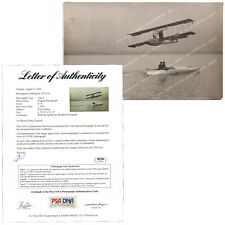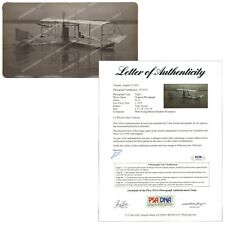When you click on links to various merchants on this site and make a purchase, this can result in this site earning a commission. Affiliate programs and affiliations include, but are not limited to, the eBay Partner Network.
Yes! We offer combined shipping for multiple orders. Thanks for shopping with OAAK Original 1913 Sepia Darkroom Generated Photo ofHistoric Aviator, TONY JANNUS Piloting a BENOISTXIIIFLYING BOAT FLOATPLANE Above Boaterswith PSA Letter of Authenticity
Brief Description:PSA/DNA LOA/COA authenticated as an Original (First Generation) authentic 9¼"x5¾" sepia-tinted B&W real photo of Tony Jannus, pilot for the St. Louis-based Beniost Aeroplane Manufacturing Company, test piloting a Benoist "Land Tractor" biplane configured as a floatplane aka the Flying Boat (Type 13, No.35: manufactured in 1913 as the 35th of 106 planes produced in the company's history). Jannus is flying above boaters on the Missouri or Mississippi River near St. Louis, while waving at the photographer. He is simply wearing a suit jacket. This photo originated from Russell Froelich, Sr.'s estate collection.
The digital scan of this photograph was watermarked for this listing to prevent plagiarismand protect the interests of the buyer.
Authentication Documents Included with Order:
- Authenticated as a Type 1 Original photo by PSA/DNA (Certificate # 1P15152) which will be included with order.
- Additional authentication is provided by email and text messages from the photographer's surviving son, Russell Froelich, Jr.
- This original photo has been out of the public domain until now.
- The photo is NOT originally collected with corner holders in the photographer's scrapbook. Reverse side of print has remnants of black scrapbook paper where previously taped. Image is in Excellent Condition with no meaningfulflaws.
- Museum Quality ready for Framing, Archiving, Display or Scanning for Resale.
- Free of Copyright History - Buyer Takes Full Ownership.
No Returns:Since this is a photograph which can be scanned in high resolution for resale, repurposing or distribution online, the original is not returnable. For this reason, you are encouraged to be a serious buyer: thoroughly read the description, do your due diligence to fully read the description, view the images, consult with experts or friends, confirm the legitimacy of the LOA by locating it on the PSA Card website and ask any questions you have before purchasing.
Shipping:This photograph will be properly packaged and shipped via Registered First Class Mail. This is the most secure form of shipment available and it requires a signature upon approval in most countries.
Payment Grace Period:We are more flexible than most sellers, allowing a 2-week grace period before canceling for non-payment. However, if buyer needs more time (e.g. for corporate or organizational net-30 A/P policies), we can accommodate.
Biographical History:
Thomas W. Benoist (December 29, 1874 – June 14, 1917) was an American aviator and aircraft manufacturer. In an aviation career of only ten years, he formed the world's first aircraft parts distribution company, established one of the leading early American aircraft manufacturing companies and a successful flying school, and from January to April 1914 operated the world's first scheduled airline.
Thomas Wesley Benoist was born on December 29, 1874, in Irondale, Missouri, the son of Pierre E. Benoist and the former Anna S. Gregory. One of the first industrialists in St. Louis, Missouri, he was a successful businessman in the automobile industry by 1904.
Louisiana Purchase ExpositionIn 1904, Benoist was among the sponsors of an unsuccessful lighter-than-air flying machine somewhat similar to a helicopter.
In March 1911, Benoist established the Benoist Flying School at Kinloch Field. At around the same time, he bought out his partner and established the Benoist Aircraft Company to build airplanes of original design. He hired aviator, Antony Habersack"Tony"Jannusas the company's chief pilot and built the first Benoist airplane of completely original design, the Type XII Headless.
By 1912, Benoist Aircraft was one of the leading aircraft companies in the world. The Type XII Headless made history when, piloted by Jannus, it carried Albert Berry over Kinloch Field on March 1, 1912, and Berry made the world's first successful parachute jump from an airplane. Improvements in the Type XII led to the development of the Land Tractor Type XII later in the year, which, configured as a floatplane, set a distance record for overwater flight. In December 1912, Benoist Aircraft produced its first flying boat, the Type XIII Lake Cruiser, which the company demonstrated widely during the summer of 1913. A larger Type XIV flying boat soon followed.
In 1913, Percival E. Fansler brought in Benoist to start an air passenger service using Benoist Aircraft's new flying boats to connect St. Petersburg and Tampa, Florida, two cities that otherwise were a day's travel apart at the time. Benoist signed a three-month contract to provide the service with the St. Petersburg Board of Trade on December 17, 1913, subsidizing 50% of the costs for starting the airline. Benoist initiated the service, the St. Petersburg-Tampa Airboat Line, using a Benoist XIV flying boat, on January 1, 1914. It was the first scheduled airline service in the world.[10] Two Benoist XIVs provided twice-daily service across Tampa Bay and by the time the initial contract expired on March 31, 1914, had transported 1,204 passengers without injury, losing only four days to mechanical problems.
Unable to secure a large contract for its airplanes during WWI, Benoist Aircraft began to experience financial problems by 1915. To reduce costs, Benoist moved the company first to Chicago, Illinois, and then to Sandusky, Ohio, where it affiliated with the Roberts Motor Company, which was Benoist's preferred source for aircraft engines. Benoist designed the Type XVI flying boat and Type XVII landplane, both of which appeared in 1916.
On June 14, 1917, Benoist died in a freak accident. Following his death, the Benoist Aircraft Company went out of business in early 1918 after constructing just over 100 airplanes in its short history.
---
The World’s First Commercial Airline piloted by brothers Tony & Roger Jannus
Aviator Tony Jannus made history on Jan. 1, 1914 by carrying the first ticket-buying airplane passenger on a scheduled run. Abram C. Pheil, the former St. Pete mayor, plunked down $400 to sit in the passenger seat. The 23-mile journey from St. Petersburg to Tampa, in a Benoist XIV “flying boat,” took 21 minutes.
The airline was known as the St. Petersburg–Tampa Airboat Line. It was organized just a few months before that New Year’s first takeoff. The airline was the brainchild of Percival E. Fansler, a Jacksonville-based electrical engineer. Fansler enlisted the support of Thomas Benoist (pronounced ben-wah), an early St. Louis-based airplane manufacturer who provided the planes-or, more precisely, the airboats. The airboat was known as Benoist Airboat Model XIV, no. 43. The model number referred to the year in which the plane was to be offered for sale (1914). The number indicated that it was the forty-third aircraft to be built from initiation of the Benoist Aeroplane Company. The Benoist Airboat was an early version of what we now know as a seaplane, able to take off and land on water. This was a necessity at the time as St. Petersburg had plenty of water but no airports. Airboat no. 43 was supplemented a little later by a second airboat, no. 45. The two airboats made up the airline’s total fleet. No. 43 accommodated one passenger in addition to the pilot. No. 45 was somewhat larger and capable of accommodating two. Benoist also provided the pilot, Tony Jannus. Tony was a test pilot for Benoist who set early records for passenger flight time and for overwater flight in 1913, and he was the pilot when Albert Berry made the first successful parachute jump.
The St. Louis-based Benoist sold this particular “flying boat” to Minnesota businessman Julius Howland Barnes in 1913, who hired the D.C.-born Jannus and his brother Roger, also a pilot, to fly thrill-seekers over Lake Superior during the warm summer months.
Powered by a Roberts 75 horsepower, 6-cylinder, water-cooled engine, the aircraft flew between five and 50 feet above the water (usually at the lower altitudes), at a maximum speed of 64 miles per hour.
As the cooler seasons approached, the brothers convinced Barnes to loan The Lark of Duluth to them for a daring new project, 1,650 miles away in Florida. The ambitious venture was to be called the St. Petersburg-Tampa Airboat Line.
------------
In 2014, a massive steel life-sized sculpture of The Lark of Duluth with the seated figures of Jannus and Pheil, mid-flight, was designed and built by sculptor Mark Aeling and erected at the St. Petersburg Pier.
The pier site is significant. For it was here – on the south side of the wooden St. Petersburg Municipal Recreation Pier – that Benoist and his business partner, Jacksonville electrical engineer Percival Fansler, constructed the hangar for The Lark of Duluth and another biplane, Florida. Jannus’ historic first flight began there, as the ungainly-looking aircraft – literally more of a boat with wings – slid down a greased ramp into Tampa Bay on Jan. 1, 1914.
Fansler, explains Michaels, was key: He cooked up the idea of scheduling flights and carrying passengers. According to Michaels, the service was pitched as both a novelty for tourists and an ultra-convenient taxi for businessmen going back and forth between St. Petersburg and Tampa. The marketing push seemed to work. In 1914, the population of St. Petersburg was around 7,000 – when launch day arrived, 3,000 people thronged the waterfront to watch the daring young flyboy and his passenger depart.
Scheduled flights – two per day, six days a week – began that day. Tickets were $5 one-way, and $10 for a round trip. The airline carried freight, too. Excursion trips, flights over the beaches or the nether regions of Tampa Bay, could be arranged for a fee.
A Jan. 14 story on the front page of the St. Petersburg Times announced that one Harry Railsback had hired Jannus to take him duck hunting in the bay; Railsback shot three “fine birds” while the Benoist was in the air. Jannus landed the plane so the downed ducks could be retrieved.
The handsome, dark-haired Jannus was a 25-year-old bachelor, and the biggest celebrity in St. Petersburg. A quote attributed to Eleanor C. Reed, his local landlady: “He was so thoughtful of others, and had such a winning personality, that he was constantly being sought after by the girls. He did not know sometimes which way to turn.”
The contract ended on May 5. The final tally: Four months of service, 7,000 air miles, a total of 1,205 passengers. Financially, the company barely broke even.
While The Lark of Duluth was back in Minnesota flying exhibitions and excursions for the summer, plans were made – between Fansler, Benoist and Jannus – to re-convene cross-bay airline service back in January, 1915.
“We have not made much money,” Benoist said, “but I believe we have proved that the airplane can be successfully used as a regular means of transportation and commercial carrier.”
During that year, however, rail service between St. Petersburg and Tampa was vastly improved, making the journey much shorter. World War I began in Europe, a conflict that would soon engulf the United States and turn the public’s attention away from novelty flying machines.
And when the city subsidy ran out, the decision was made to end the airboat experiment. It would be up to others to mold passenger aviation into a viable commercial enterprise.
In 1915, The Lark of Duluth was damaged beyond repair during a hard landing in San Diego. Tony Jannus died the following year when his plane crashed in Sevastopol, Russia, while training pilots for the war. Roger Jannus died in 1918, under similar circumstances.









